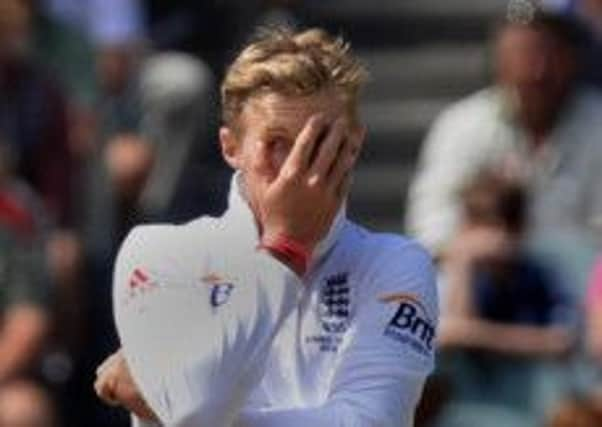Chris Waters: Root of the problem for our Joe is England’s selection carousel


For the majority of his reign as team director, England’s line-up has had a settled look.
Lately, however, it has had anything but.
Clear continuity and clarity of purpose has been replaced by something more redolent of guesswork.
Advertisement
Hide AdAdvertisement
Hide AdAt the end of the recent Ashes series, England seemed almost to be guessing their team.
Perhaps succumbing to media pressure, and the clamour for change from disgruntled supporters, they made several alterations for the last Test in Sydney.
In came Yorkshire’s Gary Ballance, Durham’s Scott Borthwick and Warwickshire’s Boyd Rankin as England chose three debutants for the first time since 2006.
Although Ballance’s selection was long overdue, the move in general smacked of panic, an almost desperate last throw of the dice.
Advertisement
Hide AdAdvertisement
Hide AdSince Andrew Strauss retired at the end of the 2012 season, ending a successful captain/coach relationship with Flower, that dice has been thrown with increasing inaccuracy.
First, there was the ill-fated dalliance with Nick Compton at the top of the order, with the Somerset man drafted in to open on the tour of India the winter before last.
In eight Test innings on that trip, Compton managed only one half-century.
Although he produced better on the subsequent tour to New Zealand, registering two hundreds against a mediocre attack, Compton struggled in the return series in England and predictably, felt many, lost his place.
Advertisement
Hide AdAdvertisement
Hide AdJoe Root, the man whom many felt should have been picked in the first place to open with new captain Alastair Cook, replaced Compton for the Ashes series in England.
The Yorkshireman did not let anyone down and, in a summer when none of England’s top-order bar Ian Bell pulled up trees, scored a respectable 339 runs at 37.66.
Granted, those figures were sweetened somewhat by an innings of 180 at Lord’s – England’s highest score of the series.
But Root did not deserve to lose his spot as an opening batsman for the winter re-match, when Michael Carberry was drafted into the side on the back of some useful performances in the warm-up games, with Root’s treatment crystallising England’s selection carousel.
Advertisement
Hide AdAdvertisement
Hide AdHaving made his Test debut against India at No 6, Root has been up and down the order like the proverbial yo-yo.
So much so, he is halfway to emulating Wilfred Rhodes’s feat of batting in every position from No 1 to No 11.
Understandably, this has shown signs of starting to mess with the young man’s head.
As some of his recent performances have indicated, Root does not know if he is coming or going.
Advertisement
Hide AdAdvertisement
Hide AdAlthough it is easy to say that he will get over it, that he is still young, that he can bat in any position that England want him, such uncertainty will do him no favours.
Every professional likes to feel secure – or at least to know what their best position is – and Root must now feel some insecurities.
It would be some surprise, in fact, if England do not admit their mistake and restore him to the top of the order for the first Test against Sri Lanka in June.
Carberry – good player that he is – was never likely to be the long-term solution at the age of 33, not that he let anyone down in Australia.
Advertisement
Hide AdAdvertisement
Hide AdAnother Yorkshireman who has been poorly treated is Jonny Bairstow.
Since scoring 95 against South Africa at Lord’s in 2012, Bairstow has not had an extended run in the side.
Although he was solid rather than spectacular in last summer’s Ashes, Bairstow was unlucky to lose his place for the last Test at the Oval.
Instead, England went for Chris Woakes at No 6 and picked Simon Kerrigan as second spinner, a decision that suggested the wheels were loosening.
Advertisement
Hide AdAdvertisement
Hide AdEngland, 3-0 up, appeared to think they could pretty much do what they liked in terms of selection.
The choice of Woakes and Kerrigan smacked of complacency.
In contrast, Australia did not rest their best players during the winter re-match but kept them on the pitch and went for the jugular.
They promptly recorded a 5-0 whitewash.
If the selection of Woakes and Kerrigan was dubious at best, the non-selection of Graham Onions for the Ashes tour was downright disgraceful.
The Durham pace bowler was the leading wicket-taker in County Championship cricket last year but was inexplicably left at home.
Advertisement
Hide AdAdvertisement
Hide AdAs those who saw him in county cricket last year would know, Tremlett was down on pace and palpably struggling.
But England bizarrely thought he could reprise his efforts Down Under in 2010-11, only to receive the rudest of awakenings.
I have not met anyone who thought it was a good idea to take the three ‘giant’ fast bowlers to Australia in the form of Tremlett, Steven Finn and Rankin and leave behind Onions.
England believed those three beanpoles would help them exploit the fast, bouncy pitches Down Under, but Tremlett and Rankin played only one Test, while Finn suffered problems with his action and did not play at all.
It was another clear sign of the plot being lost.
It was, in the context of Flower’s reign overall, most un-England-like, for if you cannot get the selections right in the first place, you are unlikely to get the right results either.